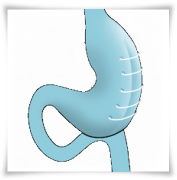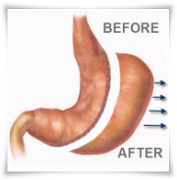Risks of Duodenum Switch
In general, the risks of duodenum switch are very high since the surgical procedure entails an extensive treatment, which many surgeons consider quite aggressive and invasive.
The treatment means two things, a reduction in the stomach size, and a change to your digestive system.
This procedure is much more invasive than a gastric sleeve, hence, there are more risks associated with it. If you are morbidly obese, you may not qualify because the risks of duodenum switch may be too great for your current condition, but you may be able to have this procedure done one step at a time, first the gastric sleeve, and after you heal, the duodenum switch.
Click here to read about other Types of Weight Loss Surgery.
What is a Duodenum Switch?
The duodenum switch, also called a Biliopancreatic Diversion with Duodenal Switch, is type of weight loss method involves two bariatric techniques: the restrictive technique and the malabsorptive technique.
The restricted part of the procedure involves the resizing of the stomach. The weight loss surgeon will be dividing the stomach vertically and will be removing about 75% of it. What will remain of the stomach will be shaped into a banana or a tube, this is basically a gastric sleeve. Afterwards, the stomach capacity will be reduced to 100 to 150 milliliters or just 6 ounces.
The malabsorptive aspect of the duodenal switch procedure requires rerouting the small intestines into 2 paths both leading to a single common channel. The duodenal switch will also keep a small part of the duodenum in the digestive system which is also a part of the small intestine. It can be located between the stomach and the jejunum or in the middle part of the small intestine.
The shorter path, which is called the ‘Digestive Loop’, carries food from the stomach to the common channel. The longer path, called the biliopancreatic loop, delivers bile from your liver to that common channel. The bile mixes with the food in the common channel, and helps you digest it before it reaches the large intestine.
How does the Duodenum Switch work?
The duodenum switch works in 2 ways:
- First, your stomach capacity is reduced, meaning you will eat less food.
- Second, your intestines have been rerouted, giving your body less time to extract nutrients from that food, so less nutrients and fat is absorbed.
This can be a very effective method of weight loss, but it can lead to some complications since your intestinal tract has been significantly altered.
The whole point of the duodenal switch is to shorten the amount of time your body has to digest food and absorb nutrients. Less calories and less fat is absorbed, and in effect, the body only absorbs about 20% of the fat. This leads to weight loss.
When undergoing any malabsorptive procedure, the amount of calories and nutrients being absorbed is reduced, thus the body will not absorb the amount of nutrients, or more importantly, the amount fat that it usually absorbs. Less fat absorbed means less fat stored, which means you will start losing weight.
How is the procedure performed?
The duodenal switch can be open surgery, but it can also be performed laproscopically. This means that your doctor will make a few small incisions in contrast to making one big incision. The surgeon will then insert a small viewing tube with a camera called a laparoscope and some other small instruments into the incision to carry out the duodenal switch procedure. The smaller incisions will mean a shorter recovery time, and less scarring.
Is this procedure reversible?
It is only partially reversible. The reduction of the stomach cannot be reversed, once that piece is taken out, it’s gone forever. However, the intestinal bypass part of the duodenal switch can be reversible if you are one of those patients who have experienced any complications.
Risks of Duodenum Switch
Like most surgeries, the duodenum switch has its own accompanying risks. Some of the potential risks of duodenum switch include the following:
 Short-Term Risks of Duodenum Switch
Short-Term Risks of Duodenum Switch
- Bleeding
- Infection
- Blood clots forming in the legs.
- Problems at the healing site
- Bowel Obstruction
- Pulmonary embolism
- Abscess
- Death
Long-Term Risks of Duodenum Switch
- Kidney Failure
- Osteoporosis because calcium and Vitamin D is not absorbed
- Injury to the spleen which is required to be removed during the surgery
- Night blindness due to the inability to absorb vitamin A
- Nutritional deficiency due to the malabsorption of nutrients
- Dumping syndrome
- Foul smelling stool and gas
As a result from these risks of duodenum switch, the patient may need to stay in the ICU for a monitored recovery. And since some of the risks of duodenum switch are mostly long term, it may not be manifested in the early part of the healing process. If you want to lose weight through a surgical procedure, it would be best to consult your doctor about the benefits and the risks of duodenum switch.

